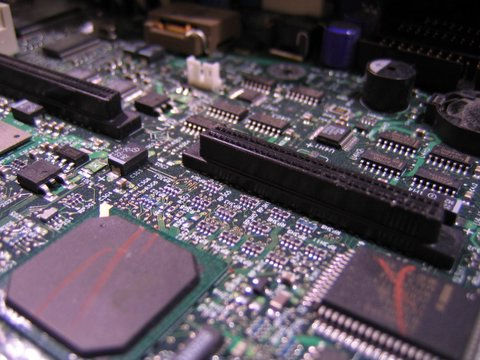 Teaching Guide
Teaching Guide
In the Motherboard Mania curriculum, the student will take a look at what a motherboard looks like and the major components that reside there. The student will explore the internet and find out what the motherboard and its components do and how the motherboard interacts with its various components.
Because technology is always changing, a student must be able to find the latest information about the equipment he/she is working on. The student will use the internet to obtain up-to-date information that will keep him/her current in the information technology industry.
Students will become familiar with the components of the motherboard. Students will be able to identify each part of the motherboard and what function is plays in the computer. Students will be able to use the Internet to help find technical definitions and images. Students will be able to use the Internet to compare two up-to-date, noteable motherboards and write a comparison paper about them.
Through this curriculum, students will become familiar with a computer motherboard and its many components. When students looks at a computer, they only see a box. What that box contains are the most important parts. The use of the internet to look at each different component of the motherboard will allow students to have an up-to-date learning experience.
The motherboard, or system board, acts as a computer system’s nerve center. Every computer system device that is used plugs into, is controlled by, and depends on the computer’s motherboard to communicate with other computer system devices. In the world of information technology, the capabilities of motherboards and their components are constantly being upgraded. Students need to be aware of what is currently happening in the world of motherboards. Students should be able to gather information about various motherboards and their manufacturers and make a comparison about which would best fit their needs.
When students looks inside the system box of a computer, they need to know what the different motherboard components look like. They also need to know where these components reside on the motherboard. Each motherboard is different and the locations of components may differ slightly between manufacturers. Common components that should be recognized by the student are the chipset, CPU interface (slot or socket), expansion slots, RAM slots (SIMM and DIMM), IDE controller, floppy disk drive controller, battery, CMOS chip, BIOS, power supply socket, ports, internal buses, and jumpers.
Not only does the student need to know what components look like and where they are located on the motherboard, he or she need to know what each component does and how the components interact. Each component on the motherboard has a specific job that it has to do in order for everything to work correctly. Students should also have knowledge of how information is moved from one component to another and how all these components interact.
When students learn what the different components of a motherboard are and how these components work together, they will begin to understand how a computer works. To get the most current information about motherboards and their components, the internet is the best source. This field is constantly changing and developing new and improved computer parts and students need to be aware of what is happening in this industry.
This Curriculum web was developed to help students to better identify components of a computer. Specifically the motherboard and its major components. It is to be used as additional reference material for students to use in their classroom. Students willb e looking at components, finding what eac components job is on the motherboard, and ten demonstrating their knowledge of where each component resides on the motherboard. Students will also look at what the industry says are the top motherboards and write a comparison of two top motherboards.
The activities of this curriculum web are designed for high school students (grades 9-12). However, it can be used with middle school students.
Before beginning the curriculum web, students should be able to:
This curriculum web is centered on the subject matter surrounding motherboards and their components. The student will identify the following motherboard components:
Indiana Business & Information Technology Content Standards
National Educational Technology Standards for Students Standards
This curriculum web is intended to be used with the Aries PC Maintence and Repair: Hardware course following the unit on motherboards. The outcome should be a complete understanding of the computer motherboard and its components.
It is suggested that the instructor be available to help guide the students, but the students should complete all work on their own.
Resources
Lori Nossett, lnossett@gibsoncounty.net
Home | Introduction | Task | Process | Resources | Evaluation | Conclusion | Credits